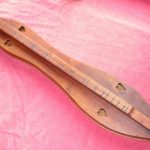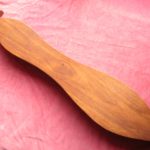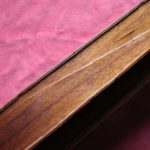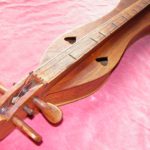Amburgey
Ralph Lee Smith in his seminal work “Appalachian Dulcimer Traditions” recounts that Jethro (1895 – 1971) began his education in an old log schoolhouse near his home. At the age of 11, his parents agreed to him attending the larger Hindman Settlement School in Kentucky, ten miles from the family home, providing he would “work his way”.
At Hindman, Amburgey met dulcimer maker “Uncle” Ed Thomas, one of the classic early dulcimer pioneers. Thomas supposedly made frequent visits to the Hindman workshop and Amburgey’s interest was piqued by the instruments he built and sold in the Hindman store. He recalled seeing Thomas walking past the school workshop one day with a half-dozen or so dulcimers and going into a meeting of the settlement women. A while later, Thomas returned without a single instrument; he had sold them all! Amburgey figured that if people wanted dulcimers so much, he too should learn how to make them. When he asked for patterns, however, Thomas said that he would only provide them if Amburgey paid him more than he would receive for a finished instrument. Amburgey duly obliged and the dulcimers that he started building, as a result, were closely modelled on the Thomas original – a narrow, shallow hourglass with fiddle sides and staple frets under the melody string only. The earliest Amburgeys date from the 1920s. By the early 60s, he had made only 500 dulcimers (charging $35 at the time). With demand accelerating, by his death in 1971 he had completed over 1300.
This dulcimer is a dark reddish walnut – possibly stained – throughout, from tail block, through fingerboard to headstock. But whereas much is solid wood, the body is made from a high quality walnut laminate – a conscious decision following problems with splitting in his earlier solid bodied instruments. Interestingly, the laminate variant is slightly heavier than the solid wood one. Top and back extend over the sides in the traditional manner, sometimes termed “fiddle-edging”. The back is secured at the headstock end by four tacks and at the tail by five. The top has four heart soundholes pointing to the tail. The single piece fingerboard has a scribed mark ⅛” from each edge on top and side – and across the fingerboard to mark the position of each fret. There are 17 short staple frets, set only to the near side of the fretboard. No 6½ fret. Interestingly, on this later model, the nut and bridge is cut to allow an alternative position for the middle string: much closer to the melody string and over the frets, hence useable as a frettable double melody course. It has three hand cut walnut pegs in a simple, stubby scroll headstock; separate walnut bridge and endblock; single string anchor.
This particular instrument [N.B. NOW SOLD] is generally in good condition for its age and is eminently playable. A small area of the far top edge has been chipped and glued. Two small laminate surface areas at each end of the back have been chipped and then stabilised with glue. Glue lines along the whole back suggest this superficial damage may have resulted from more substantial damage on the far side and/or by removing the back to repair it. There is an impact depression on the far side upper bout, near the waist, which has caused a 10” crack. This has been solidly glued and is not moving at all, but remains a rather clumsy repair. Overall length 32½”, upper bout 4½”, lower bout 5¾”, depth 1⅝”, FBW 1⅛”, VSL 28″ (medium/long scale), weight 1lb 11oz (770g). No 6½ fret.




